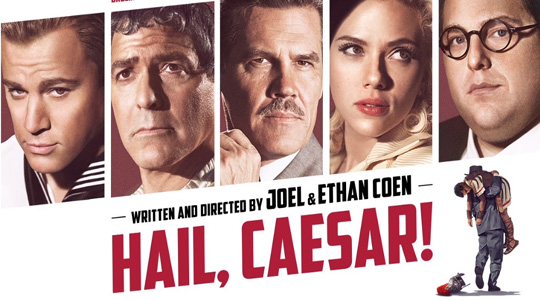
Hot on the heels of the Oscar-nominated Trumbo, another 1950s-set movie about Hollywood Reds has been released. The prolific Coen Brothers’ Hail, Caesar! is a zany Tinseltown satire with an all-star cast that rather promiscuously – and drolly – mixes fact and fiction. Although you wouldn’t know it from the movie’s somewhat deceptive, widespread advertising,Caesar‘s subtext revisits the specter that haunted Lalaland then: Communism. The Coens had tackled this topic in 1991’s Barton Fink, inspired by that playwright of proletarian theater, Clifford Odets, and his imagined movie colony misadventures.
Josh Brolin portrays MGM (called here, rather pointedly, “Capital”) veep Eddie Mannix, a real-life character known as a “fixer,” due to tough tactics he deployed to rather zealously guard stars’ errant private lives in order to protect studio interests. (Some suspected this exec/enforcer of foul play, including mob ties and involvement in the 1959 gunshot death of TV’s Superman, George Reeves, who’d romanced Mannix’s wife – Bob Hoskins portrayed Mannix in the 2006 film Hollywoodland about Reeves’ mysterious end.)
Most of Caesar‘s other fact-based characters, however, have a nom de plume – or, rather, nom de film, as the case may be. Trying to pierce Mannix’s cone of silence over his wayward talents is Oscar winner Tilda Swinton in a double role as the Hollywood gossip columnists (who hate that appellation) Louella Parsons and Hedda Hopper, here called Thessaly and Thora Thacker, rival tabloid twins. (Helen Mirren’s dead-on incarnation of the wretched Hopper earned her a Golden Globe nom for Trumbo). Scarlett Johansson depicts Esther Williams, known for her aquatic exploits on film, as DeeAna Moran, a naughty nautical nymphomaniac.
Venezuelan Veronica Osorio of the Upright Citizens Brigade quite fetchingly portrays Carlotta Valdez, who seems to be a cross between the Brazilian “Tutti Frutti girl” Carmen Miranda and that “Mexican Spitfire” Lupe Vélez. In a kooky cameo Frances McDormand (Joel Coen’s wife) plays the film editor C.C. Calhoun, who seems inspired by Hollywood’s most fabled female editor, Dede Allen (she cut 1981’s Reds, and remember that great montage at the end of 1967’s Bonnie and Clyde, when Warren Beatty and Faye Dunaway get whacked in a hail of bullets?).
Channing Tatum plays the Gene Kelly-like actor/dancer Burt Gurney, who conducts espionage for Moscow. Kelly was near the Hollywood Left, and his former wife Betsy Blair (Oscar-nommed for 1955’s Marty) ran afoul of the Hollywood Blacklist and was either a close fellow traveler or “card carrying, dues paying member” of the CPUSA. Kelly’s third wife, née Patricia Ward, presented a one-woman show about her late husband at the Pasadena Playhouse, and she told me Kelly was “very progressive.”
A clownish George Clooney plays fatuous star Baird Whitlock. It’s hard to pinpoint the thesp who inspired this character, since the Hollywood of the 1950s had so many blithe celebs. Nevertheless, Whitlock has a pivotal role: While acting in one of that era’s religious epics which, like 1959’s Ben Hur, was set during the Roman Empire (hence the title, Hail, Caesar!), Whitlock is kidnapped by a pair of lefty extras acting in cahoots with a cell of Communist Party screenwriters. They discuss dialectical materialist gobbledygook at their Malibu seaside lair, which is reminiscent of John Wayne’s Hawaii-set Reds-under-the-beds 1952 Big Jim McLain, wherein the Duke busts a commie ring in the islands, starring as a Joe McCarthy-type HUAC investigator, whose name even has the Wisconsin senator’s initials. (Big Jim McLain was actually suggested by the case of the Hawaii 7, although Wayne’s agitprop flick twisted this persecution of Hawaii labor organizers.)
Screenwriters such as Dalton Trumbo and John Howard Lawson were especially persecuted during the Red Scare, although the Malibu cell is led by an academic called Prof. Marcuse – a clear reference to the Marxist theoretician Herbert Marcuse, who wrote One Dimensional Man and whose students included Angela Davis. The socialist cell’s Marxist musings are derived from Das Kapital with a “K” – in contrast to Capital studio with a “C.” Cold War propaganda justified witch-hunting of LaLaLand leftists because, among other things, it was alleged that they were Soviet agents acting in collusion with those gremlins in the Kremlin, undermining mom and apple pie with the secret socialist sauce in their scripts.
Hail, Caesar! has great fun lampooning this canard. Of course, none of the blacklisted North American-born filmmakers went into exile behind the so-called “Iron Curtain” – Joseph Losey went to England, Ben and Norma Barzman to France, Trumbo to Mexico, etc. While they may have been pro-Soviet, they were motivated more by pro-labor, anti-racist, anti-fascist motives than by love for Uncle Joe and Moscow, where – as said – none of them settled.
This offbeat spoof of Hollywood and the Cold War is sly, wry and zany, although there are only a few laugh-out-loud moments (unlike the Coens’ hilarious 1987 Raising Arizona and their funnier 1996 Fargo). Hail, Caesar! also includes recreations of classic Hollywood tableaux with great pictorial panache from Westerns, musicals (full of homoerotic camp), swim scenes and religious spectacles (movies which, the Coens imply, propagated America’s ideological response to Marxism). Hail, Caesar! is not so much a screwball comedy per se, but rather a wacky, inventive, original goofball comedy.
Joel and Ethan Coen, who also gave us 1998’s The Big Lebowski (reportedly inspired by indie avatar Jeff Dowd), also co-wrote the recent powerful dramas Bridge of Spies and Unbroken, proving that the creators of Hail, Caesar!‘s anti-anti-Communist romp are forces to be reckoned with in the Hollywood Babylon Empire. Hail, Coens!
Photo: Official site












Comments